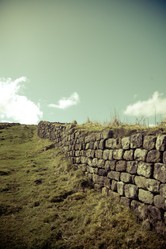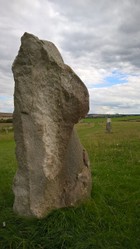Archaeologists and detectorists need luck. Many pass their lives seeking the one find that will bring fame, but at Melsonbury, a quiet English village, luck eventually came true, not gold or silver, far from it, but a trove of historically valuable artefacts, Lady Luck had struck. More precious than gold, they provide knowledge, the precise location of the site is secret, to protect it from ravagers These artefacts will enjoy a proud place in a museum in the ancient city of York.Photos courtesy of GingerMari'e12, courtesy of Pixabay

The Melsonby Hoard
by frankbeswick
A lucky find on a piece of grassland made for a find of ancient artefacts, which has put an English village on the map.
The Yorkshire Iron Age
Yorkshire, the Northern English name for much of the area east of the Pennine Hills, is England's largest county, so large that in the nineteenth century it was split into three. However, the inhabitants still call themselves Yorkshire folk. It is a land of great swathes of countryside, much industrial heritage, and a great deal of history, not all of it peaceful, as it fought a long conflict with my native Lancashire during the Wars of the Roses in the fifteenth century. The land is well-known for its archaeology, as it has a long history of inhabitation reaching back to the stone ages. But archaeology is a matter of chance discoveries. People walk over ground little knowing that an archaeological find is a foot or so beneath their feet. This was so at the peaceful village of Melsonby, in North Yorkshire. The find was not in the village itself, but in some open land nearby. It appears that the piece of land had for a long time been grass, pasture for animals. It does not seem to have been ploughed for many years, if ever. Then in 2021 a detectorist got permission from the landowner [necessary, by law] and began to search. The detectorist had never found anything significant, but he had found something of archaeological significance. He did his legal duty by reporting the find to the landowner and then to the police The archaeological department at a nearby university was allocated the job of excavation. The exploration had begun.
It may be significant that Melsonby is near Stanwyk, the large earthwork where the Queen of the Brigantes, Cartimandua, had her base. Cartimandua was not only a queen, but a goddess to her people. The Brigantes were a large tribe who derived their name from Brige, a Celtic goddess, who was embodied in the tribal queen.. They were a large confederation of smaller tribes, but they were almost certainly a matrilineal society. Such societies were known in Britain for a long time. The Picts of Scotland reckoned inheritance of the throne through the female line. Yet in some matrilineal societies, the queen could dispense with the king and choose a more suitable lover. It is very likely that in these matrilineal societies the king so dispensed with would be ritually slain, a fate that might have befallen the bog bodies found over North West Europe. The thinking behind this is that the king must be vigorous for the tribe to be healthy and the corn to grow. We do not know whether ritual sacrifice was on the cards for Cartimandua's husband, or whether or not ritual sacrifice was still practised, but Julius Caesar, writing in the first century BC, speaks of its being done among the druids But we are told that Cartimandua's husband Venutius had taken umbrage against her statement that she was going to divorce him and marry her much younger armour bearer. If this rejection involved a ritual sacrifice we can imagine his not being enamoured by the prospect. He rebelled, and she, who was an ally of Rome, appealed for Roman help. Rome sent a light force of auxiliaries to rescue Cartimandua and she fades out of history. But Venutius held the throne and there was ongoing Brigantian resistance to Rome well into the next century.
We are dealing with what is probably a funeral site. But there is no evidence of violence at the site. The connection with Cartimandua is by association, but we cannot go further on this matter. As Cartimandua was around in the year 70 AD. She is probably a bit late for this burial, which is probably from the first century BC.
Treasure Trove
A team of archaeologists got on the job and worked over two years to excavate the site, and only now in early 2025 has the site's existence been public knowledge. There was no treasure so the law of treasure trove did not apply.. Treasure trove is a legal status which is applied to gold and silver items discovered. Gold and silver items discovered are presumed to be the property of the one who buried them. If no owner can be proven they are the property of the crown. This does not mean that they are the personal property of the king b but they belong to the state. The discovery of gold and silver items must be reported promptly to the police. Neglect of this duty can be a crime. If treasure trove is proven the finder and the landowner share the market value, but failure to report promptly can be detrimental to entitlement to this share.
The Items.
Chariot burials are known in Yorkshire, but the remains found in the Melsonby site seem to be four wheeled wagons, more suitable for trade than war. What is significant is that the vehicles seem to have been ceremonially burnt in a pyre before inhumation. This implies that we are dealing with the cremation of a wealthy person. He or she, we have no means of identifying whether it was male or female, could afford to have interred twenty eight iron tyred wheels. The site contains remnants of horse harnesses of high quality adorned with glass ornaments. This was a very wealthy person , and considering that we are dealing with a body from a matrilineal society it is not beyond possibility that this is a queen's grave,
The sum total of artefacts exceeds eight hundred items of iron and copper, including llnch pins for horses. Many, however, are fragmentary. A few weapons are present,these being two ceremonial spears. This is not the grave of a great warrior. We know of female chariot burials from the region of Yorkshire. Significantly, there are two vessels, one a drinking bowl which was probably for wine. But we must realize that medications were..administered with wine, so it is possible that the grave contains a healer. The other vessel is suggestive of a healer or an an enchantress. This is a cauldron, I do not regard this as a male tool. So this, I,suggest, is a female who was deemed to have healing or, spell binding powers. The cauldron came with a chain for hanging the vessel over a fire. This is in keeping with its being a culinary tool, and likely to belong to a woman. The glass and coral beads probably are the product of trade with continental Europe, most likely the Mediterranean regionindicating that Brigante society was an advanced tradIng society.
But who was she? She might have been one of Cartimandua's predecessors as queen or at least a very high ranking female. She may have been a healer. As the earthly embodiment of Brige, a kindly goddess whose special field of work was the family, the home and child birth she was unlikely to be a goddess/queen with a warlike character
You might also like
The Legacy of Rome in BritainThe Romans stayed in Britain from 43 AD to 407, but the impact of their prese...
Blick Mead: Stonehenge's sacred springArchaeological discoveries near Stonehenge throw light upon the origins of th...



 Women of the Gospelson 10/11/2025
Women of the Gospelson 10/11/2025
 Religious Gardenson 08/25/2025
Religious Gardenson 08/25/2025
 Doctor of the Church: John Henry Newmanon 08/03/2025
Doctor of the Church: John Henry Newmanon 08/03/2025
 Restoring the Palm Houseon 07/16/2025
Restoring the Palm Houseon 07/16/2025


Comments
We have never had such a ride.
Thank you for your comment below, in answer to my previous observation and question.
The computer crashed before I could convey another component of my iron-rimmed-wheels question.
Have you or your wife or your children or Veronica or her husband or her children ever had an iron-rimmed-wheel wagon ride?
If so, is it less comfortable or more comfortable than, or the same as, a rubber-rimmed-wheel wagon itinerary?
Iron rims sèm to have been the desired technique for use in wheeled vehicles
On another matter. I have a. Magazine which contains an article of interest to you. It is on the gap sycamore. Send me your postal address and I will post you the magazine, if you want the article.
The second subheading, The items, advises us that "Chariot burials are known in Yorkshire, but the remains found in the Melsonby site seem to be four wheeled wagons, more suitable for trade than war. What is significant is that the vehicles seem to have been ceremonially burnt in a pyre before inhumation. This implies that we are dealing with the cremation of a wealthy person. He or she, we have no means of identifying whether it was male or female, could afford to have interred twenty eight iron tyred wheels."
The following question connects with the afore-considered even as it connects more with contemporary contexts in that it concerns rubber versus metal tires.
Does the quote above divulge for us ancient tires with iron rims, different from modern tires with rubber rims?
It is hard to say, as the items were badly corroded,
Thank you for your comment below in answer to my previous observation and question.
The first paragraph to the second subheading, The items, advises us that "Chariot burials are known in Yorkshire, but the remains found in the Melsonby site seem to be four wheeled wagons, more suitable for trade than war. What is significant is that the vehicles seem to have been ceremonially burnt in a pyre before inhumation. This implies that we are dealing with the cremation of a wealthy person. He or she, we have no means of identifying whether it was male or female, could afford to have interred twenty eight iron tyred wheels. The site contains remnants of horse harnesses of high quality adorned with glass ornaments."
Did the chariots display wear-and-tear or did the burial practices demand destroying with the dead their earthly possessions regardless of their appearance and functionality?
There is not a negotiation between the finder's claim and the state. The state's representative makes a decision on the value. If there is any disagreement then a court could deal with the case, but I know of no case where any disagreement has occurred.
The fourth, Treasure trove paragraph to the first subheading, The Yorkshire Iron Age, advises us that "There was no treasure so the law of treasure trove did not apply.. Treasure trove is a legal status which is applied to gold and silver items discovered. Gold and silver items discovered are presumed to be the property of the one who buried them. If no owner can be proven they are the property of the crown. This does not mean that they are the personal property of the king b but they belong to the state. The discovery of gold and silver items must be reported promptly to the police. Neglect of this duty can be a crime. If treasure trove is proven the finder and the landowner share the market value, but failure to report promptly can be detrimental to entitlement to this share."
Does the market-value payment to the finder and the landowner divorce them from all dealings with gold- and silver-coin discoveries?
Coroners are called only if there is a body, even if it 8s only a skeleton. The police have the responsibility of invoking the coroner.
Thank you for your comments below in answer to my previous observation and question.
So the detectorist contacts the landowner and the police. Your answer then elucidates that "There is a public official who needs to be informed by the police."
That answer also fits a coroner into the equation if the detectorist finds a body.
Who must call the coroner: the detectorist, the landowner, the police or someone else?